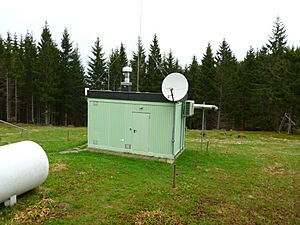Comprehensive Nuclear-Test-Ban Treaty Organization facts for kids
The Comprehensive Nuclear-Test-Ban Treaty Organization (CTBTO) is an international group working to stop all nuclear tests around the world. It will officially start when a special agreement, called the Comprehensive Nuclear-Test-Ban Treaty, becomes law. This treaty makes nuclear test explosions illegal.
The CTBTO's main job will be to check that no country is doing nuclear tests. To do this, it will use a global system to listen and look for any signs of explosions. It can also send teams to inspect places if needed. The CTBTO's main office is in Vienna, Austria. A group called the Preparatory Commission for the CTBTO was set up in 1997 to get everything ready.
Contents
Why the CTBTO is Important
Nuclear tests are very dangerous. They can harm people and the environment. The CTBTO helps make the world safer by trying to stop these tests. Scientists believe that past nuclear tests caused serious health problems for many people.
When the Treaty Starts
The Comprehensive Nuclear-Test-Ban Treaty will officially begin 180 days after 44 specific countries have agreed to it. These countries are listed in the Treaty because they have nuclear reactors or advanced nuclear technology.
As of November 2023, 41 of these 44 countries have signed the Treaty, and 35 have fully agreed to it. Some countries, like India, North Korea, and Pakistan, have not signed or agreed to the Treaty. Others, like China, Egypt, Iran, Israel, and the United States, have signed but not yet fully agreed. Russia signed and agreed, but later changed its mind before the Treaty could start.
Getting Ready: The Preparatory Commission
The Preparatory Commission for the CTBTO was created in 1997. Its job is to prepare for the Treaty to start. This includes setting up a system to check for nuclear tests.
A big part of this preparation is building and running the International Monitoring System (IMS). This system has 337 stations around the world. It also includes a special data center in Vienna and a global communication network. The Commission also writes guides on how to do on-site inspections.
How the CTBTO Checks for Tests: The International Monitoring System (IMS)
The IMS is like a giant ear and eye for the world. When it's finished, it will have:
- Seismic stations: 50 main stations and 120 backup stations that listen for earthquakes and underground explosions.
- Hydro-acoustic stations: 11 stations that listen for sound waves in the oceans.
- Infrasound stations: 60 stations that use special sensors to detect very low-frequency sound waves, which can come from large explosions.
- Radionuclide stations: 80 stations that collect air samples to find tiny radioactive particles. These particles can be released by nuclear explosions in the air, underground, or underwater.
- Radionuclide laboratories: 16 labs that analyze the samples from the radionuclide stations.
All the information from these stations is sent to the CTBTO's International Data Centre (IDC) in Vienna. This happens through a special global network, mostly using satellite links. Countries that are part of the Treaty can access all this data to help check for nuclear tests. As of 2023, about 90% of this system was already working.
Checking a Suspicious Event: On-Site Inspections (OSI)
If the IMS detects something suspicious, or if there's another reason to worry that a nuclear explosion happened, the CTBTO can conduct an On-Site Inspection (OSI). This is like sending a detective team to investigate.
An OSI can only happen after the Treaty officially starts. At least 30 of the 51 members of the CTBTO's Executive Council must agree to it. A team of up to 40 inspectors would search an area as large as 1,000 square kilometers (about 386 square miles). Only countries that are part of the Treaty can ask for an OSI.
During an OSI, inspectors use many tools:
- They look for clues and take pictures.
- They use special equipment to measure ground vibrations and radioactivity. This includes looking for gases like argon-37 and xenon isotopes.
- For longer inspections, they can use more advanced tools like ground penetrating radar to see what's underground.
- They can even drill into the ground to collect samples if they suspect an underground explosion.
The CTBTO is always looking for new scientific and technical ways to make these inspections even better.
Images for kids



